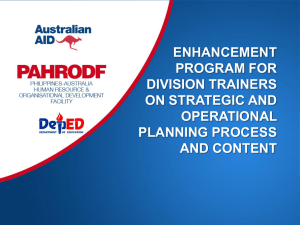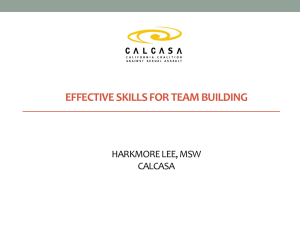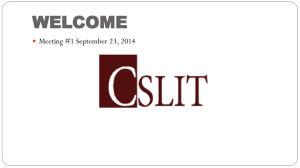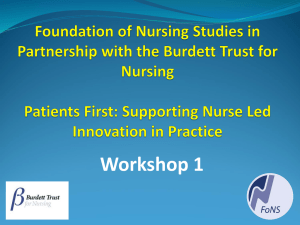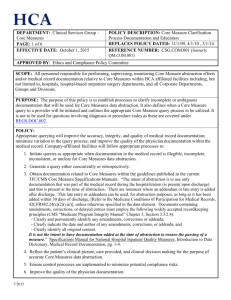Precision Q+A Workshop - The High Cost of Doing Nothing Workshops
advertisement
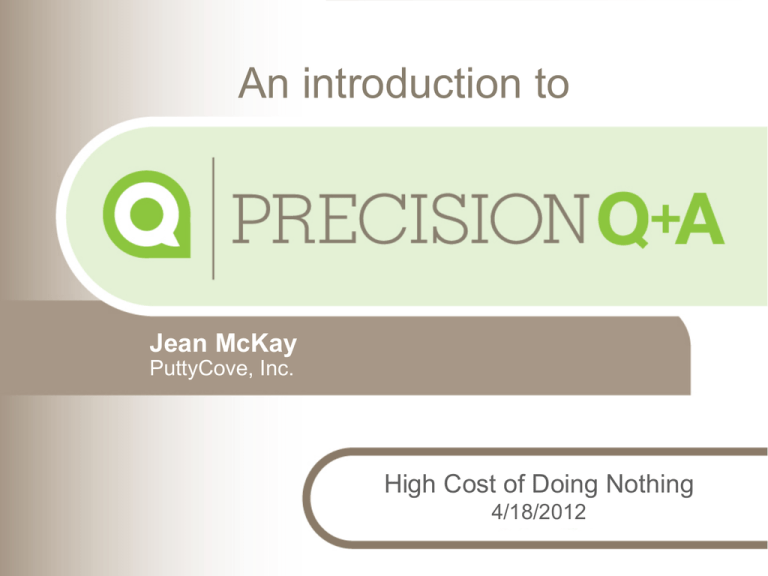
An introduction to Jean McKay PuttyCove, Inc. High Cost of Doing Nothing 4/18/2012 About Jean McKay, PMP, PMRMP, MSCIS Jean is an experienced professional with a proven track record over 20 years. She currently holds numerous professional certifications in both Project Management and IT, focuses on Disaster Recovery Planning, Business Continuity Planning, Risk Assessment, and Technical Training. Jean is a certified Project Management Professional (PMP)®, and Risk Management Professional PMP-RMP, with a Master of Science in Computer Information Systems. Jean currently resides in Phoenix, Arizona, and is an active member of the PMI Phoenix Chapter, BPW, and Infragard. Background for this work Fifteen years of development at Stanford University Observations or interviews with 225 executives 25 longitudinal studies of executives In 2007, 55 formal interviews in 9 industries In-depth study of PQ+A in two global companies • Cypress Semiconductor, 1996 to 2004 • Microsoft, 1995 to 2004 -3- Four deep trends Information overload Higher levels of complexity Complexity is dynamic Increased time crunch The pressure to improve discussion Time The efficiency of typical business meetings -4- Two factors Two factors make it difficult to manage complexity and overload in meetings Answers that destroy focus Questions that lack focus -5- When answers lack focus Not clear Not crisp Not concise -6- What’s going wrong? She asks a precise question • “What are the unit sales for the urban and suburban segments?” He hears a generic question • “Give me an update.” He believes he’s helping the discussion by providing “valuable context” -7- Precision Answering solves the problem The basics of PA • Answer the question that was asked • Start with the core • Keep it short The benefits of PA • Better focus • Greater efficiency -8- When questions lack focus Low efficiency No depth -9- What’s going wrong? We shouldn’t be asking this: • What do the lines show us? If the question in our mind is this: • At the end of the quarter, what was the rate at which sales were decreasing? • Is the rate of decrease slowing down or speeding up? - 10 - Precision Questioning solves the problem The basics of PQ • Be precise • Get to the heart of the matter The benefits of PQ • Greater efficiency • Better analysis - 11 - Precision Questioning Drill-down questions fall into seven categories - 13 - The seven categories Our customers are spending more time on social networking sites. - 14 - The seven categories Our business needs to start doing better security of our data. - 15 - Let’s Practice We will use your issue to practice the categories one at a time Real PQ is more fluid - 16 - Practice: Write down an issue like one or the other of these ___ is taking more ___ [time, resources, etc.] than expected. Use a real issue from your work Write legibly ___ is more complex than expected. - 17 - Instructions for two-minute drills Find a partner to practice with. Decide roles • One person presents issue & answers questions • Other person asks questions Don’t change roles until instructed to These are practice drills for the questioner; this will not be a fluid discussion. Real PQ is more fluid than this. • Answers should be short, honest, and realistic Please wait to begin - 18 - Establish the big picture 2 minute limit Presenter starts • Show partner the written statement • Give an overview of your issue (about 30 seconds) Then questioner asks • Ask questions that help you understand the big picture (about 60 seconds) • Big picture questions are mostly clarifications so you understand the topic • Do not worry about the categories for now • 2 minute limit - 19 - Go/NoGo questions guide energy and focus Setting up a good meeting • • • • Who should participate? Goal? How much time? Who should tee up the issue? Shaping the direction once the meeting begins • Are we focused on the right thing? • Are we asking the right questions? • Should we take this off-line? - 20 - Reminder: these are not Go/NoGo questions How do you track resources? What do you mean by “complex?” What seems to be causing it? For now – focus only one Go/No Go questions - 21 - Examples of Go/NoGo questions OK • Who should attend? Better • Who knows more about this, Ellen or Bill? OK • What would be the goal of the meeting? Better • Is a half-hour enough time to both review the data and figure out the underlying causes of the problem? - 22 - Practice Go/NoGo questions 2 minute limit ___ is taking more ___ [time, resources, etc.] than expected. Ask questions that would help them set up a real meeting to discuss this issue ___ is more complex than expected. - 23 - Clarification questions sharpen the meaning By “clarification” we mean clarification of the meaning of words and sentences Three main types of clarification • Clarifying slippery words • Asking graph questions • Asking pivot table questions - 24 - Clarification of slippery words A “slippery” word means one thing to one person and something different to another person OK • What do you mean by “complex”? The project has become more complex than we expected. Better • Complex in what ways? • Do you mean complex with respect to number of parts? • Complex with respect to number of dependencies? - 25 - Reminder: these are not clarification questions Do you have data on your use of resources? What seems to be causing it? If you don’t change anything, what would be the consequences? For now – focus on Clarifying slippery word questions - 26 - Practice clarifying slippery words 2 minute limit ___ is taking more ___ [time, resources, etc.] than expected. Clarify words that might mean something different to the presenter than to you. ___ is more complex than expected. - 27 - Clarification through graph questions The project is taking more time than expected. “Draw the graph” with questions • When did the schedule first slip? • How far have you fallen behind the original projections? • Are you losing ground or gaining ground? - 28 - Clarification through pivot table questions Pivot table questioning Improving morale is turning out to be more difficult than we expected. • Picture the parts • Question the parts Examples • Show it to me by ___ (gender, age, location). • Where has morale been the most difficult to improve? • Where has morale been easiest to improve? - 29 - Practice graph/pivot table clarification 2 minute limit ___ is taking more ___ [time, resources, etc.] than expected. Graph questions Pivot table questions ___ is more complex than expected. - 30 - Assumption questions go deep An assumption is something that must be true in order for the statement to be true The difficulty: assumptions are in what is not said Useful tip: phrase your questions this way • Are you assuming…? • Are you assuming…? - 31 - Common categories of assumptions “I’m looking for the solution to the problem of…” Existence • Are you assuming a problem exists? Uniqueness • Are you assuming there’s only one problem? Measurement • Are you assuming you can measure improvement? Value • Are you assuming it’s bad? Time, Constancy • Are you assuming the problem isn’t changing over time? - 32 - Practice assumption questions 2 minute limit ___ is taking more ___ [time, resources, etc.] than expected. Are you assuming...? Are you assuming...? Are you assuming...? ___ is more complex than expected. - 33 - BCQs ask for evidence Two main types of BCQs • Questions about the validity of the data • Questions about the credibility of the sources of information - 34 - BCQ: questions about the validity of DATA Not • How do you know that’s true? OK • What’s the data? Better • • • • How complete is the data? How accurate is the data? Is the sample representative of the population? Is the sample large enough? - 35 - Practice DATA questions 2 minute limit ___ is taking more ___ [time, resources, etc.] than expected. Ask questions about the validity of their data ___ is more complex than expected. - 36 - BCQ: questions about the credibility of the SOURCES of information OK • Where did you hear this? Better • Did you hear it from somebody who was on the project at the beginning? • Do you have 100% confidence in what they are telling you? • Should you check with other people who were on the project at the beginning? - 37 - Practice SOURCE questions 2 minute limit ___ is taking more ___ [time, resources, etc.] than expected. Ask questions about the credibility of their sources of information ___ is more complex than expected. - 38 - Establish the big picture – switch roles 2 minute limit New presenter • Show your written statement (about 30 seconds) New questioner • Ask questions that help you understand the big picture (about 60 seconds) • Big picture questions are mostly clarifications • Don’t worry about categories, this is so you understand the topic - 39 - BCQs ask for evidence Two main types of BCQs • Questions about the validity of the data • Questions about the credibility of the sources of information - 40 - Practice BCQs – DATA and/or SOURCE 2 minute limit ___ is taking more ___ [time, resources, etc.] than expected. Ask about validity of data Ask about credibility of sources of information ___ is more complex than expected. - 41 - Cause Questions Questions about causes help us control Here are five precise why’s • • • • • What triggered this (an event)? Is there a root cause (a condition of vulnerability)? What is the mechanism (how does it work)? What are the drivers (pushes)? What are the inhibitors (pulls)? - 42 - Cause questions OK • Why were our initial expectations so unrealistic? Better • Was the root cause that fact that this was a different type of problem than we have seen in the past? OK • Why is it becoming more complex? Better • What are the main drivers of complexity? - 43 - Practice cause questions 2 minute limit ___ is taking more ___ [time, resources, etc.] than expected. Root cause? Trigger? Drivers? Inhibitors? Mechanism? ___ is more complex than expected. - 44 - Questions about Effects help us predict When thinking about the future, we tend to oversimplify This 3x3 matrix helps us be more precise Best case Worst case Most likely Short term Medium term Long term - 45 - Effects questions OK • How long will it take? Better • Worst case, how long will it take? OK • What will be the result? Better • What will the long-term consequences be? - 46 - Practice effect questions 2 minute limit ___ is taking more ___ [time, resources, etc.] than expected. Ask questions like this: • Suppose you don’t change anything. In the ___ term, what’s the ___ case for ___? ___ is more complex than expected. - 47 - Questions about Action There are many more options than “what should we do about it?” • • • • What is our strategy? What tactics will we use to enact our strategy? What is our plan for the coming week? Is our goal a root cause fix? Or is it just containment? - 48 - Practice action questions 2 minute limit ___ is taking more ___ [time, resources, etc.] than expected. Ask questions like these: • Can you do a root-cause fix on this? • Should you just try to contain it? ___ is more complex than expected. - 49 - Benefit of PQ What is the benefit of making our questions more precise? • It helps us analyze our work in new ways • Our meetings become more efficient • The level of critical thinking goes up - 50 - Tools, not rules - 51 - Precision Answering - 52 - PQ can’t get very far without PA • In the first video, Jordy does not hear the Precise Question • He hears, ‘Tell me a story’ - 53 - Precision Answering solves the problem The basics of Precision Answering • Answer the question that was asked • Start with the core • Keep it short - 11 - Focus on Precision Answering PA: Conveying only the important information in a crisp, clear, and concise way - 86 - Three basic rules of PA Answer only the question that was asked Start with the core Keep it short - 87 - Three basic rules of PA – Rule #1 Answer only the question that was asked • Don’t answer the question you wanted them to ask • Don’t answer the question you think they should have asked • Make sure you heard the question • If the question isn’t clear to you, clarify - 88 - Three basic rules of PA – Rule #2 Start with the core • Core answers go right to the point Common core answers • • • • • • • Yes No Number Date Single point Bullet points I don’t know + next step - 89 - Three basic rules of PA – Rule #3 Keep it short • Many times the core answer will suffice • At most, add one or two additional points • When adding necessary information, use bullet points when possible There are three top concerns . . . We have two options . . . - 90 - Additional options Clarify the question Redirect the questioner Add qualifiers Do a torpedo alert Anticipate the next question, only when obvious Keep the discussion moving forward - 91 - Find the precise answer Q: What’s the status of the project? A: Well I made the phone calls to our customers that you asked me to. I think people were in general pretty positive, though ABC Retailer had some concerns about the timing, but I think we can work around their schedule by doing a phased implementation of the plan. The rest of our customers are fine with the schedule, so I think we should be on schedule to deploy next month, with again the exception of ABC Retailer which will deploy the system in the next two months. - 92 - Core answer plus information Find the precise answer Q: Why did the schedule slip? A: I want to say that we have been working very hard to make the schedule, but as you know the schedule is very aggressive and we are working on a new system, so we are doing our best. We have been having some problems integrating the new system with the manufacturing process. We are not sure, but we think it has something to do with an incompatibility between the new system design that used an XYZ process and our manufacturing design that used the old ZYX process, but at this point it is just a guess. - 93 - Single point answer plus I don’t know Practice Precision Questions & Answers Visit www.vervago.com Skill Sharpeners that build skills The PQ+A 1 day Workshop • Teaches four things: PQ PA plus two additional techniques • Workshop creates high impact three ways: Focuses on real issues How to make practical application Post-workshop emails to deepen the learning - 65 - Thank You ! Questions? Contact me! Email: jean@puttycove.com Call: 623.210.7312 Website: www.puttycove.com LinkedIn: http://www.linkedin.com/in/jeanmckay www.vervago.com Ask better questions and give better answers - 66 -

